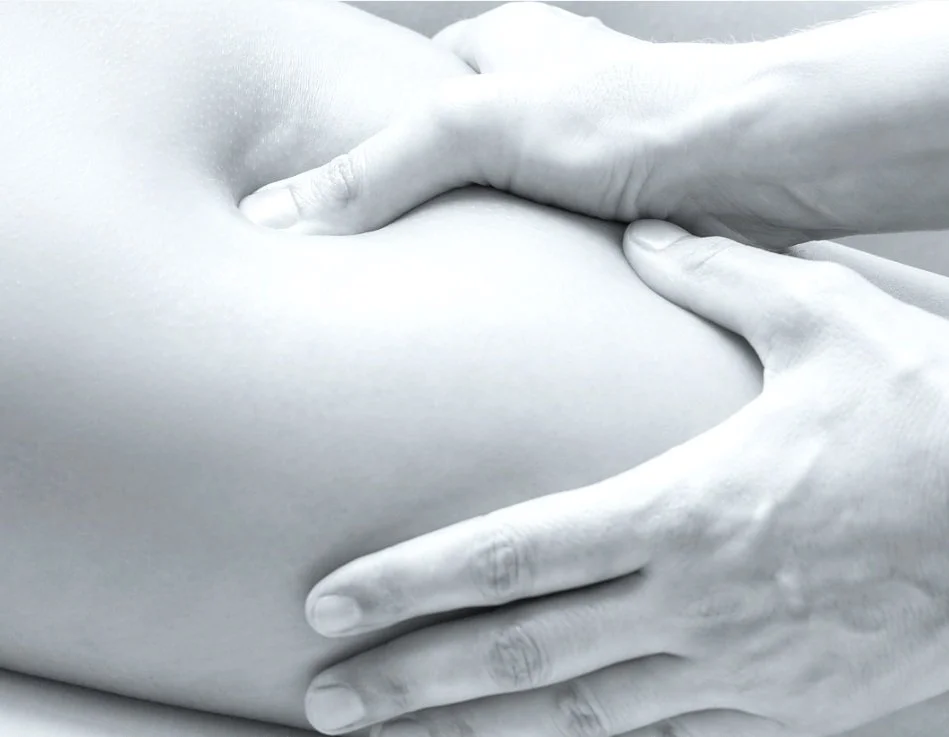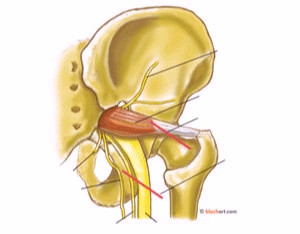
Piriformis Syndrome
The “sciatica” you feel could be piriformis syndrome
Piriformis Syndrome is more pervasive than many physicians realize. For example, in the United States each year, 1.5 million people have lumbar MRI scans to look for the cause of the buttock and leg pain called “sciatica.”
Yet more than 1.2 million of those scans fail to find the cause in the spine. Three hundred thousand of the scans are sufficiently positive that the patient has lumbar spine surgery. And of the 300,000 surgeries, as many as 25% fail to relieve the pain — in many cases because the diagnosis of a spinal cause for the sciatica was incorrect.
Piriformis syndrome also causes sciatica. Its treatment is much less invasive and severe than the treatment of herniated lumbar disks. However, many doctors never consider piriformis syndrome as a possible diagnosis. Many physicians who are aware of it are uncertain how to properly diagnose and treat it.
Dr. Aaron Filler credits the advent of MR Neurography and Open MR injection techniques with new large-scale outcome as leading to the successful diagnosis and treatment of many more sciatica sufferers.
We have three sections of content below focused on piriformis syndrome. They include:
- Information
- Diagnosis
- Treatment
Please review our TOS information, and complete the response form on this page to request an appointment with Neurological Injury Specialists and Dr. Aaron Filler in Santa Monica, California.

Information on Piriformis Syndrome
Anatomy of Piriformis Muscle and Sciatic Nerve
Piriformis Syndrome and Sciatica Anatomy
This drawing illustrates the important anatomy for piriformis syndrome.
The nerve-related leg pain of Sciatica is often due to piriformis muscle syndrome. Unlike the sciatica from a herniated disk, there is often little or no back pain while buttock pain predominates. The pain is worse when sitting, relieved by standing or walking, and often extends no farther down the leg than the ankle or mid-foot. When toes are involved, it usually affects all five toes.
Certain leg positions pull the piriformis muscle up against the sciatic nerve causing buttock pain and radiating leg pain.

Physical Exam Findings and Key Symptoms
Piriformis Syndrome Physical Exam
Animation: Critical physical exam for muscle based piriformis syndrome.
The patient’s foot is placed lateral to the contralateral knee. Resisted abduction or adduction against the examiner’s hand may reproduce the symptoms. Straight leg raising is typically negative.
Relief can be obtained by traction on the involved leg, particularly by pulling upwards at a ten to twenty degree angle and towards the contralateral side. Symptoms usually involve both L5 (big toe) and S1 (small toe) components.

Image Anatomy for Injections
Anatomy of the piriformis muscle and sciatic nerve in a T1 weighted axial MRI scan
Animation: This T1 weighted axial MRI scan shows the anatomy used to guide the injection of the piriformis muscle in an Open MRI scanner.

Diagnosis of Piriformis Syndrome
(A) Coronal T2-weighted neurographic image section. The yellow arrows indicate the sciatic nerves at the point of passage through the sciatic notch – the sciatic nerve on the left demonstrates hyperintensity.
(B) Axial T1-weighted MR image showing asymmetry in the size of the piriformis muscles. This may reflect either hypertrophy on the right or atrophy and spasm on the left. Muscle spasm may change the shape and hardness of a muscle without altering its total volume.
(C) Curved reformat image of the sacral spinal nerves, lumbo-sacral plexus and proximal sciatic nerves again showing the hyperintensity consistent with irritation of the left sciatic nerve and its antecedents.
(D) Axial T2-weighted image showing hyperintensity and loss of fascicluar detail in the left sciatic nerve at the point of passage through the sciatic notch.

Treatment of Piriformis Syndrome
Outpatient minimally invasive surgical treatment
New minimal access, outpatient surgery greatly improves outcome and reduces recovery time
Piriformis surgery is now a small procedure which can be carried out under local anaesthetic as an outpatient. Traditional piriformis surgery is a large and debilitating operation but no patient should be having these operations today. There were two types of traditional piriformis surgery, one involves a large lateral hip incision similar to the approach used for a hip replacement surgery. The second involves a very large incision and involves completely detaching all of the gluteal muscles from the iliac crest. Both of these types of surgery result in weeks of debilitation, walking on crutches and pain, with only limited success treating the original problem.
The new type of “minimal access surgery” developed at the Institute for Nerve Medicine by Dr. Aaron Filler involves only a small incision, and in most cases can be performed on an outpatient basis. Large scale formal outcome trials involving hundreds of patients with follow-up out to eight years show no detectable effect on normal walking in any of the patients – this a great change from the traditional surgery that often leaves permanent problems with gait. Recovery takes only a few days in most patients.
Those patients who have positive physical exam findings, positive MR neurography findings and a clear positive response to MRI guided piriformis injection have had a 85% to 90% good to excellent outcome.

Open MRI Guided Injection of the Piriformis Muscle
Piriformis Injections
The piriformis muscle is a relatively small structure located as far as eight inches below the surface of the buttock. If a blind injection misses the muscle, the injection test is meaningless. Immediately deep to the piriformis muscle is the sciatic nerve and the colon so misplacement of the needle may lead to significant complications.
Dr. Aaron Filler’s use of Open MRI image guidance makes this a safe, reliable and accurate procedure. In these images, the physician’s finger is seen indicating the angle of approach in the first image. In subsequent views, local anesthetic is injected in the skin and then a titanium Lufkin needle is introduced and advanced into the piriformis muscle. An injection of Marcaine (10cc of 0.5% solution of this long-acting local anesthetic) and 1cc of steroid medication is then seen darkening the interior of the muscle in the last two image frames.
These flash MRI images each take about 12 seconds to complete. In about 20% of cases the injection is therapeutic and the piriformis syndrome resolves completely and permanently. In others, the injection needs to repeated in a few months, and in still others, it last only a few days. In this category, surgery may be required to maintain the pain relief. Thanks to Dr. Filler’s technique, piriformis surgery is now a small procedure which can be carried out under local anesthetic as an outpatient.


Meet Dr. Filler
A globally recognized expert in the treatment of peripheral nerve disorders and the development of nerve imaging technology, Dr. Aaron Filler is the world’s leading expert in treatment of nerve pain. He has revolutionized nerve-pain treatment by inventing several new technologies. One such technology, MR Neurography, enables doctors to use an MRI scanner to examine nerves, previously a difficult-to-impossible tissue to visualize with MR imaging.
Dr. Filler’s research in axonal transport is leading to a whole new generation of advanced pain medications. He has developed many new “minimal access” surgery methods that allow him to treat complex nerve problems with small outpatient surgeries. He has also pioneered the use of the Open MRI scanner to do surgeries and other therapies with the ultra-high precision and safety of the magnetic resonance imaging.
At Dr. Filler’s Neurological Injury Specialists Management Group in Santa Monica, California, the key to success remains a very traditional endeavor: listening to the patient and doing a thorough and expert neurological examination. Dr. Filler typically spends more than an hour with each new patient. The results of the initial examination are then strengthened and perfected with application of advanced technology available nowhere else in the world.
Dr. Aaron Filler combines three key components in his treatment of each patient:
- Compassionate personal attention,
- Expert medical skills, and
- The best technology in the world
He combines these components to turn insoluble pain problems into specific treatable diagnoses. Prior to coming to the Institute for Nerve Medicine, many of Dr. Filler’s patients have seen a dozen doctors (or more), experienced failed surgeries, and have even had their very pain questioned. Time and again, Dr. Filler demonstrates that in many of these cases the problem is the doctor and not the patient. A cure is in reach when the best available medical care is brought to bear.
Dr. Filler has an MD from the University of Chicago, a PhD from Harvard University, and is also a Fellow of the Royal College of Surgeons in England. His medical training included four years of medical school, eight years of neurosurgical training at one of the leading neurosurgery programs in the US, an additional one-year fellowship in neuroimaging at the University of London, another year of training in complex spinal surgery at UCLA, and a fellowship in peripheral nerve surgery with Dr. David Kline in New Orleans.
He is the inventor on ten major patents, has published more than twenty prominent scientific publications, and has done more than a hundred presentations at scientific and medical meetings. He is also the author of Do You Really Need Back Surgery? from Oxford University Press, a well-received 300-page book for the general public. He enjoys medical staff privileges at Cedars-Sinai Medical Center in Los Angeles.

Take control today
Request an appointment with Dr. Aaron Filler
Please note that all fields are mandatory. For fastest service, please call us at (310-314-6410) between 9AM-5PM Pacific.
